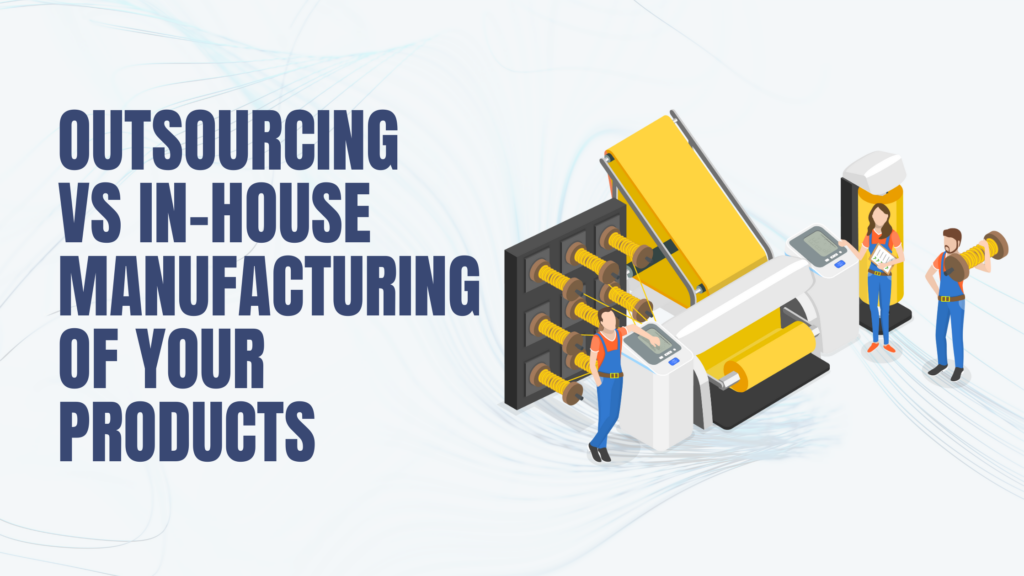Outsourcing vs In-House Manufacturing of Your Products
In the era of competitive business, companies face the constant challenge of optimizing their production processes to meet customer demands while minimizing costs and maximizing efficiency. One critical decision that businesses must make is whether to outsource their manufacturing needs or keep production in-house. Both options have their advantages and disadvantages, and choosing the right approach depends on several factors unique to each business. In this blog, we will explore the key considerations when deciding between outsourcing manufacturing and in-house production, helping you make an informed decision that aligns with your business goals.
Content
Understanding Outsourcing Manufacturing
Disadvantages of Outsourcing Manufacturing
Disadvantages of In-House Production
Factors to Consider When Choosing Between Outsourcing and In-House Production
Finding the Right Balance in the Middle
Understanding Outsourcing Manufacturing
Outsourcing manufacturing involves partnering with third-party suppliers or contractors to produce goods or components. This approach allows businesses to leverage the expertise and resources of external providers, focusing their internal efforts on core competencies such as research and development, marketing, and customer service.
Here are some advantages and disadvantages associated with outsourcing manufacturing:
Advantages of Outsourcing Manufacturing
1. Cost Efficiency and Scalability
Outsourcing production can often result in significant cost savings. By partnering with established manufacturers, businesses can benefit from economies of scale, reduced labor costs, and streamlined supply chains. Moreover, outsourcing provides scalability, enabling companies to scale their production capacity up or down based on market demands without incurring substantial fixed costs.
2. Access to Specialized Expertise
Outsourcing manufacturing allows businesses to tap into specialized knowledge and expertise. External suppliers often have extensive experience and resources dedicated to specific industries or product categories. By leveraging their expertise, businesses can benefit from improved quality, innovation, and efficiency in their manufacturing processes.
3. Focus on Core Competencies
By outsourcing production, businesses can redirect their internal resources and efforts towards their core competencies. This strategic allocation of resources enables companies to concentrate on activities that differentiate them in the market, such as product development, marketing, and customer service.
4. Reduced Capital Investment
Outsourcing manufacturing eliminates the need for significant upfront investments in infrastructure, equipment, and production facilities. This can be particularly beneficial for startups and small businesses with limited capital resources, allowing them to allocate funds to other critical areas of their operations.
Disadvantages of Outsourcing Manufacturing
1. Loss of Control and Flexibility
When outsourcing manufacturing, companies relinquish a certain degree of control over their production processes. Relying on external suppliers means that businesses are dependent on their performance, quality standards, and ability to meet deadlines. Additionally, outsourcing may limit the flexibility to make rapid changes or customization to products, as it requires coordination with the external supplier.
2. Potential Quality Control Issues
Maintaining consistent quality standards can be challenging when relying on external suppliers. Differing quality control measures, communication gaps, or geographical distance can lead to variations in product quality. Businesses must establish robust quality control processes and maintain open lines of communication with their suppliers to mitigate these risks.
3. Intellectual Property Concerns
Sharing sensitive information, proprietary designs, or trade secrets with external suppliers exposes businesses to intellectual property risks. Protecting intellectual property becomes crucial when outsourcing manufacturing, as unauthorized disclosure or misuse of proprietary information can harm a company’s competitive advantage.
Exploring In-House Production
In-house production refers to the process of manufacturing goods or components using a company’s internal resources, workforce, and facilities. This approach provides businesses with direct control over the entire production process, from concept to delivery. Consider the following advantages and disadvantages of in-house production:
Advantages of In-House Production
1. Enhanced Control and Quality Assurance
One of the key advantages of in-house production is the ability to maintain complete control over the production process. This control facilitates direct oversight and ensures consistent quality standards. Businesses can implement stringent quality control measures, monitor production closely, and make real-time adjustments to optimize the manufacturing process.
2. Faster Response Times
In-house production enables businesses to respond quickly to market demands and changing customer preferences. With internal manufacturing capabilities, companies have the flexibility to make rapid changes, introduce new product variations, or customize orders without relying on external suppliers. This agility can give businesses a competitive edge in fast-paced industries. A crucial factor often overlooked when deciding between in-house production and outsourcing is the impact on a company’s internal operations and team efficiency. By having tight control over manufacturing processes, businesses can optimize internal communications using effective internal communications tools. This ensures seamless coordination among departments and aligns with strategic goals, thereby supporting better product quality and timely delivery.
3. Intellectual Property Protection
By keeping production in-house, companies can better protect their intellectual property and trade secrets. Controlling the entire manufacturing process minimizes the risk of unauthorized disclosure or misuse of proprietary information, ensuring that a company’s competitive advantage remains intact.
4. Better Integration with R&D and Innovation
In-house production facilitates seamless integration between research and development (R&D) and the manufacturing process. Close collaboration between R&D teams and production personnel fosters innovation, enabling faster iterations, product improvements, and efficient problem-solving. This synergy can lead to enhanced product development and continuous innovation.
Disadvantages of In-House Production
1. Capital Intensive
Establishing and maintaining in-house production capabilities requires significant upfront investments. Businesses must allocate funds for infrastructure, equipment, machinery, and skilled labor. These capital expenses can strain the financial resources of startups and small businesses, potentially limiting their growth opportunities.
2. Expertise and Skill Gaps
Developing and retaining a skilled workforce for in-house production can be challenging. Finding qualified personnel, providing training, and ensuring consistent skill development requires time and resources. Additionally, technological advancements may necessitate ongoing investments in training and development to keep pace with industry standards.
3. Limited Scalability
In-house production may pose limitations on scalability, especially during periods of rapid growth or fluctuating demand. Expanding production capacity may require additional investments in facilities, equipment, and human resources. Scaling up in-house production can be a complex process that requires careful planning and resource allocation.
Factors to Consider When Choosing Between Outsourcing and In-House Production
Making an informed decision between outsourcing manufacturing and in-house production requires a comprehensive evaluation of various factors specific to your business. Consider the following key considerations:
Cost Analysis
Conduct a thorough cost analysis to compare the financial implications of outsourcing versus in-house production. Consider factors such as initial investments, ongoing operational costs, labor expenses, supply chain management, and potential cost savings or efficiency gains.
Quality Control and Assurance
Evaluate your ability to maintain consistent quality standards and control over the manufacturing process. Assess whether outsourcing suppliers can meet your quality requirements and whether in-house production would provide better control and assurance.
Scalability and Flexibility
Consider the scalability of your production needs and the ability of outsourcing suppliers to meet fluctuations in demand. Assess whether in-house production would provide greater flexibility and agility in responding to market changes and customer demands.
Intellectual Property Protection
Assess the importance of protecting your intellectual property and trade secrets. Determine the level of risk associated with sharing sensitive information with external suppliers and evaluate the safeguards in place to protect your proprietary designs and know-how.
Control and Communication
Assess the level of control you desire over the manufacturing process and the potential communication challenges associated with outsourcing. Consider the impact of language barriers, cultural differences, and time zone variations on effective collaboration and coordination.
Financial Resources and Risk Tolerance
Evaluate your financial resources and risk tolerance when considering investments in infrastructure, equipment, and skilled labor. Assess the potential returns on investment and weigh them against the financial risks associated with in-house production.
Long-Term Strategic Goals
Align your decision with your long-term strategic goals. Consider whether outsourcing or in-house production better supports your growth objectives, market positioning, and competitive advantage in the industry.
Finding the Right Balance in the Middle.
The decision between outsourcing manufacturing and in-house production is not a one-size-fits-all approach. Each business must carefully consider its unique circumstances, goals, and resources to determine the most suitable manufacturing strategy.
By assessing the key factors discussed in this blog, businesses can make an informed decision that aligns with their specific needs and objectives. Choose wisely, as your manufacturing strategy can significantly impact your company’s growth, competitiveness, and success in the market.





